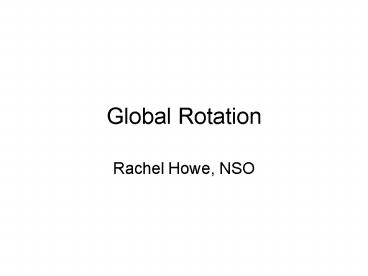Global Rotation - PowerPoint PPT Presentation
Title:
Global Rotation
Description:
Convolve averaging kernels with test profiles to simulate inversions. ... Convolve with each W to get noise-free profile. Add in noise. Generating Artificial Data ... – PowerPoint PPT presentation
Number of Views:39
Avg rating:3.0/5.0
Title: Global Rotation
1
Global Rotation
- Rachel Howe, NSO
2
How deep is the tachocline, how wide is the shear?
- With almost a whole cycle of observations from
GONG and MDI, we can look at the stationary part
of the rotation. - Forward-modeling exercises help to establish
robustness of results.
3
The Questions
- How well can we measure the near-surface shear?
- Is the slant in the convection-zone rotation
real? - How well can we measure the shape of the
tachocline?
4
The Data
- 106 overlapping 108-day sets from GONG, covering
10.5 years 1995-2006. - 0?l150, coefficients up to a16
- 49 72-day sets from MDI, starting May 1996.
- 0l300, coefficients up to a36
5
Analysis
- Fit 11yr sinusoid to each coefficient
- Use stationary part of fit
- 2dRLS and 2dOLA inversions
- Convolve averaging kernels with test profiles to
simulate inversions.
6
Analysis the inversion problem
Kernel
Averaging Kernel
7
Generating Artificial Data
8
Generating Artificial Data
- The long way around
- Use Eq. 1 to calculate di from the desired W.
- Add ei with the correct s.
- Do the inversion.
- Repeat for each realization.
- The shortcut
- Calculate the K once for a grid of (r,q).
- Convolve with each W to get noise-free profile
- Add in noise.
9
Generating Artificial Data
10
Coefficients
11
Results profiles
GONG
MDI
6,2 RLS
7,3 RLS
OLA
12
Results profiles
GONG
MDI
7,3 RLS
6,2 RLS
OLA
13
Global Rotation Profile
- Dashed lines inclined at 25 degrees to rotation
axis.
14
Slope of Isorotation Contours
- Dashed line shows slope of radial lines.
- Gilman Howe, 2003 (BB proceedings).
15
Results Synthetic Profiles
GONG
MDI
6,2 RLS
7,3 RLS
OLA
16
Results Synthetic Profiles
GONG
MDI
6,2 RLS
7,3 RLS
OLA
17
Results Synthetic Profiles
GONG
MDI
6,2 RLS
7,3 RLS
OLA
18
Results Synthetic Profiles
GONG
MDI
6,2 RLS
7,3 RLS
OLA
19
Discussion
- Slope in convection zone looks robust
- Near-surface shear already resolved in single-set
data - But reversal at high latitudes may be MDI(CA)
artefact. - Some sensitivity to different tachcocline
thickness.
20
Calibrating the Tachocline
- Charbonneau et al (1999) used fits with error
function model convolved with 1d averaging kernel - Tried this using OLA inversions, checking against
synthetic profiles.
21
Fit Results (MDI OLA)
22
But
- We know rotation isnt quite depth-independent in
convection zone. - What does technique do with tilted-contour model
and no thickness?
23
Aha!
Fits to tilted-contour model
Fits to real data
Fits to dashed-contour model
24
So
- Try fitting model with slope in convection zone
taken into account, combined with error-function
tachocline.
25
And we get this
26
From which we conclude
- Deconvolution fitting does not work perfectly.
- Forward modeling is only useful if the model is
appropriate! - The tachocline could be quite thin,
(0.030.04)Rsun once the slanted rotation
contours are taken into account. - However, this still needs more study.































